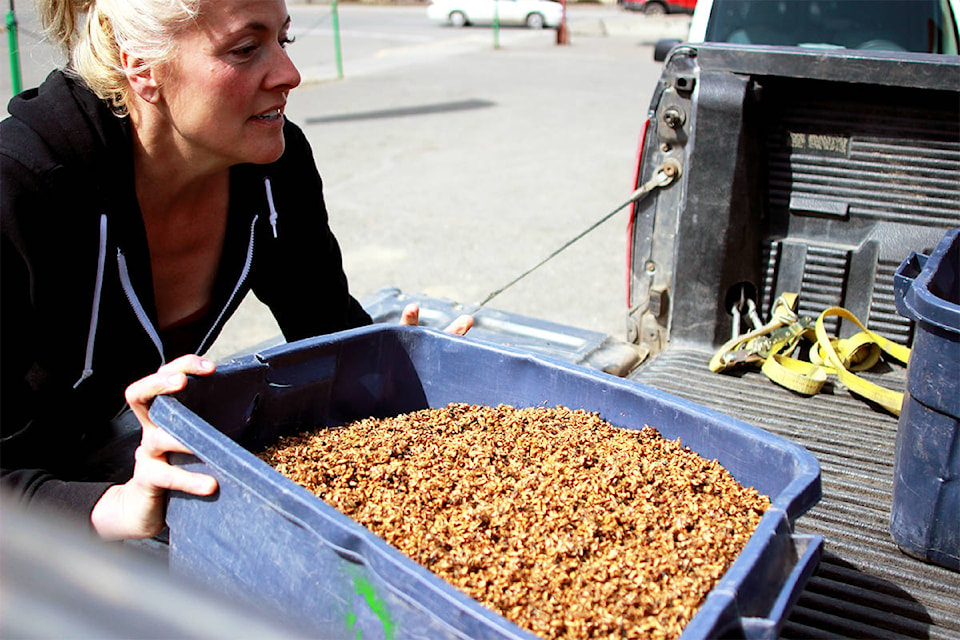It was all grunts and squeals from inside the pen as the wheelbarrow of spent grains got closer - one by one, the pigs mustered together, anxiously waiting to eat their dinner.
A lot of the animals seem to like the grains such as the horses, chickens, sheep and goats. But, it’s the pigs who seem to enjoy them the most.
Helena Lake Ranch owner, Amber Summerhayes, has been feeding the animals on her ranch spent grains, that she collects from Jackson’s Social Club and Brew House.
RELATED: Waste not: Kootenay brewery leftovers feed the local food chain
“I have been getting the spent grains from the brewery for a year now,” she said.
About once a week, Summerhayes makes a trip into 100 Mile House from her farm in Lac la Hache to collect the spent grains.
Summerhayes knew barley (grains) were being used to make the beer, but she didn’t know what was being done with them after the fact.
“I have always fed my pigs grain and I knew Keith was using them,” she said. “So, I thought I would try and see if we could make an arrangement for me to take the spent grains off his hands. It has worked for the both of us, ever since.”
In the final steps of the brewing process, Keith Jackson, owner of the Social Club, will begin loading the steaming grains into buckets for Summerhayes to pick up. One batch of beer will fill roughly eight buckets of grains.
“Once I am done with the grain, there is roughly 200 pounds of spent grain, there isn’t much left in it, but animals seem to like it,” said Jackson. “Over the last three years, I have had a few different farmers take it off my hands.”
Shortly after, Summerhayes will come by the brewery and load them into her truck. One haul of grains is a weeks worth of food for the pigs.
“There is so much that gets wasted and we are a small farm, so every little bit counts,” said Summerhayes. “I have never liked feeding my animals food from a restaurant, so this is a great alternative.”
The pigs are fed twice a day. In the morning, they are fed scraps from the kitchen or what the local food bank can’t repurpose and in the afternoon, they are fed the grains.
Jackson said the most common grain he uses is barley.
“There is no alcohol in the grains,” he said. “Once the beer is in its final stages and the yeast is added, it eats away at the natural sugars - creating alcohol.”
How craft beer is made:
There are several steps in brewing craft beer. A single batch can take approximately nine hours before it is ready to begin fermenting and then matured. Once every step is complete, Jackson will have enough beer to fill seven 50 litre kegs.
Depending on the kind of beer, different types of malt will be crushed together to break up the grain kernels to extract fermentable sugars to produce a milled product called grist.
The grist will then be transferred into a mash tun, where it’s mixed with heated water. This break’s the malt’s starch down into sugars.
The mash will be pumped into a lauter tun and a sweet liquid (wort) is separated from the grain husks. The wort collects in a vessel called a kettle and it is brought to a controlled boil before hops are added. Once the wort has been boiled, it is transferred into a whirlpool for the wort separation stage.
While the wort is being separated, any malt or hop particles are removed, leaving a liquid that is ready to be cooled and fermented.
During fermentation, yeast is added.The yeast converts the sugary wort into beer by producing alcohol.
Once the beer has been fermented it will go through a cellaring process. Jackson said it takes about two weeks before the beer is ready to be kegged.
newsroom@100milefreepress.net
Like us on Facebook and follow us on Twitter.
